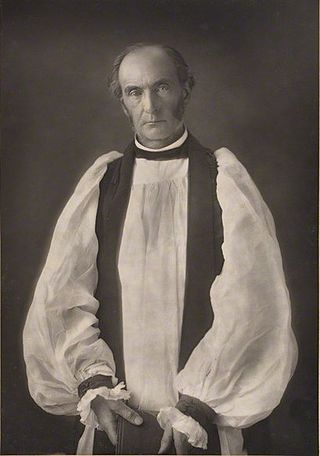
Saint Patrick's Cathedral in Dublin, Ireland, founded in 1191 as a Roman Catholic cathedral, is currently the national cathedral of the Church of Ireland. Christ Church Cathedral, also a Church of Ireland cathedral in Dublin, is designated as the local cathedral of the Diocese of Dublin and Glendalough.

Christ Church Cathedral, more formally The Cathedral of the Holy Trinity, is the cathedral of the United Dioceses of Dublin and Glendalough and the cathedral of the ecclesiastical province of the United Provinces of Dublin and Cashel in the (Anglican) Church of Ireland. It is situated in Dublin, Ireland, and is the elder of the capital city's two medieval cathedrals, the other being St Patrick's Cathedral.
The Regius Professorships of Divinity are amongst the oldest professorships at the University of Oxford and the University of Cambridge. A third chair existed for a period at Trinity College Dublin.

William Conyngham Plunket, 4th Baron Plunket was Dean of Christ Church Cathedral and Archbishop of Dublin in the Church of Ireland.

The Dean of St Patrick's Cathedral is the senior cleric of the Protestant St Patrick's Cathedral, Dublin, elected by the chapter of the cathedral. The office was created in 1219 or 1220, by one of several charters granted to the cathedral by Archbishop Henry de Loundres between 1218 and 1220.
William Fuller (1608–1675) was an English churchman.

The United Dioceses of Dublin and Glendalough is a diocese of the Church of Ireland in the east of Ireland. It is headed by the Archbishop of Dublin, who is also styled the Primate of Ireland. The diocesan cathedral is Christ Church Cathedral, Dublin.
The Archbishop of Dublin is the head of the Archdiocese of Dublin in the Catholic Church, responsible for its spiritual and administrative needs. The office has existed since 1152, in succession to a regular bishopric since 1028. The archdiocese is the metropolitan see of the ecclesiastical province of Dublin, and the archbishop is also styled the Primate of Ireland. The cathedral church of the archdiocese is Saint Mary's Pro-Cathedral in Dublin city, although the Church formally claims Christ Church as its cathedra, and the archbishop's residence is Archbishop's House in Drumcondra.
Thomas Lancaster was an English Protestant clergyman, Church of Ireland Archbishop of Armagh from 1568.
John Garvey (1527–1595) was an Irish Protestant Bishop of Kilmore and Archbishop of Armagh.
Welbore Ellis (1651?–1734) was an English bishop of Kildare, bishop of Meath and Irish privy councillor.
Thomas Lindsay, D.D., B.D., M.A (1656–1724) was an Anglican clergyman who served in the Church of Ireland as the Dean of St. Patrick's Cathedral, Dublin, Bishop of Killaloe, Bishop of Raphoe and finally Archbishop of Armagh.

Edward Parry was Church of Ireland Bishop of Killaloe, County Clare, Ireland from 28 March 1647 until his death 20 July 1650.
The Dean of Killaloe is based at the Cathedral Church of St Flannan in Killaloe in the united diocese of Limerick, Killaloe and Ardfert within the Church of Ireland. The Dean of Killaloe is also Dean of St Brendans, Clonfert, Dean of Kilfenora, and both Dean and Provost of Kilmacduagh.
The Dean of Waterford in the United Dioceses of Cashel and Ossory in the Church of Ireland is the dean of Christ Church Cathedral, Waterford.

The Dean of Cashel is the head of the Chapter of the Cathedral Church of St John the Baptist and St Patrick's Rock, Cashel, one of the Church of Ireland cathedrals of the united Diocese of Cashel, Ferns and Ossory.
The Dean of Kildare is based at The Cathedral Church of St Brigid, Kildare in the united Diocese of Meath and Kildare within the Church of Ireland.
Clonmethan is a townland and a civil parish in the ancient barony of Balrothery West, Fingal in Ireland. It is bordered by the parishes of Palmerstown to the west, Grallagh to the north, Hollywood to the northeast, Westpalstown to the east, Killossery to the southeast, Killsallaghan to the south, and Greenoge, County Meath to the southwest.
Randolph Barlow, was made Pembroke College fellow at Cambridge University in 1593; attained Master of Arts in 1594; awarded Doctor of Divinity in 1600; took holy orders and later served in the Church of Ireland as the Archbishop of Tuam from 1629 to 1638.

The Diocese of Tuam, Limerick and Killaloe is a diocese of the Church of Ireland that is located in the west of Ireland. The diocese was formed by a merger of the former Diocese of Tuam, Killala and Achonry and the former Diocese of Limerick and Killaloe in 2022, after the retirement of the separate dioceses' bishops and the appointment of Michael Burrows as bishop of the united diocese. It is in the ecclesiastical province of Dublin. It is one of the eleven Church of Ireland dioceses that cover the whole of Ireland. The largest diocese by area in the Church of Ireland, it covers all of counties Clare, Galway, Kerry, Limerick and Mayo, plus parts of counties Cork, Sligo, Roscommon, Offaly, Laois and Tipperary.








